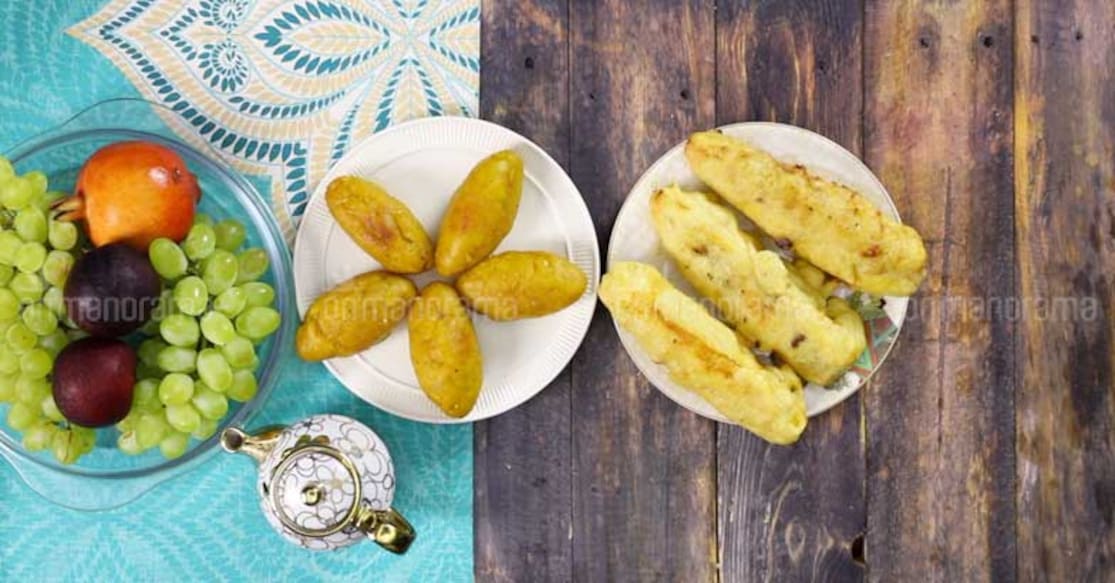Vatakara cuisine dabbles with eggs

Mail This Article
Vatakara cuisine is a different outing altogether. The dishes are quite unlike what's served in Kozhikode. Most of the sweets and savouries taste entirely different. Vatakara has a food tradition and lineage that stretches right from Kasaragod to Thalassery.
One of the startling differences is the lavish use of eggs in most dishes. For example, chattipathiri and pazham nirchathu stand out for the presence of eggs in them. Be it sweet or spicy, the Vatakara chattipathiri is happy to use of eggs and coconut milk, which explains why they are tastier and softer than their close cousins in Malabar and elsewhere. As for pazham nirachathu, the Kozhikode version has the bananas slit and filled with coconut and other mixes. It’s then dipped in flour and fried. This gets a tastier pep when the bananas are dipped in a batter of egg and rice flour and deep-fried completely in Vatakara.
The Kozhikodan samosa, the region's favourite snack looks more like an ada in Vatakara. Even though the fillings are the same, the shape is in total variance with its neighbour. Moreover, its looks are enhanced, thanks to the mould which shapes it.

Next comes the Kozhikode biryani which has huge and plentiful helpings of Leghorn and broiler chicken. But the famous Vatakara biryani comes only with broiler chicken, which is fried and then mixed with the rice.
Next in line is the traditional Vatakara payasam. In the good old days, a great deal of effort went into the making of the payasam, which also happened to be made only on special occasions. The payasam was also a tharavad-special. It was quite an elite serve. The process involved was laborious to say the least. The first step involved pounding and powdering a mix of boiled rice and raw rice. The powdered rice was then mixed with water to form a firm dough which was made into tiny balls and set aside to be steamed later.
The second phase involved extracting the first and second parts of coconut milk and cooking the required quantity of Bengal gram dal.
Now for the method. The second coconut milk extract was poured into a large flat bottomed vessel into which sugar, powdered cardamom, tiny rice balls, cooked Bengal gram dal and finely chopped bananas were added. The mix was then stirred till it turned thick. The thickening gruel would then be further stirred after adding the first coconut milk extract. Vatakara loves cooking big time. People are lavish on food that needs elaborate cooking. And their snacks are large in size. The popular tea-time pazham nirachathu undergoes cosmetic changes as it moves away from Kozhikode and lands in Vatakara. When coconut, sugar, cardamom, cashew nuts and raisins make a merry mix inside ripe bananas, Vatakara replaces the sugar with jaggery. Since the jaggery and the coconut tend to glue together, the snack tastes yummier.
The tyre pathiri is another Vatakara highlight, made with rice flour in big rounds. Interestingly, at least three to four people can partake of one pathiri. When the mixie-grinder was nowhere near the periphery of anybody’s imagination, the rice was pounded or ground. Special clay tawas were made to fry the pathiris. The dough would be covered in plantain leaves and flattened on to the tawas. They were then turned over and over again and flattened till they were well cooked on both sides. Since they were pretty thick, it had to be ensured that they were well cooked.

Yet another Vatakara special is mutta ada. About five to six eggs and the required quantity of sugar are beaten till the mix turns fluffy. Small quantities of the mix are then poured on to a tawa and cooked on both sides. They are then folded in a special shape.
Vatakara’s kalathappam is almost the same as what’s dished out in Kozhikode.
Manda is another sweet savoury. It’s a larger version of the samosa. The filling comes from a mix of fried semolina, ghee, cardamom and sugar. The savoury is tastier when made with powdered boiled rice rather than semolina. The manda is special to Vatakara in that it’s one of the sweet savouries sent along with the bride when she leaves her home for her husband’s.

Kozhikkal, another popular dish along the Vatakara-Thalassery belt is made by frying thinly sliced, batter-covered cassava or tapioca.
Another Vatakara special is the large rice pathiri. The rice is pounded and powdered and made into a dough. Vegetables, chicken, beef and prawns go in as fillings. The dough is wrapped in plantain leaves and flattened on to a tawa. When its half done, the fillings along with crushed coconut, fennel and shallots are wrapped in. If the pathiri has chicken fillings, the pieces are fried and placed along the sides of the pathiri and another pathiri is placed over it and sealed. This forms a heavy snack with rich fillings between two heavyweight pathiris. The pathiris are placed in large steamers and cooked. This is one tasty platter!
Muttapathiri is another simple make. Basmati rice or raw rice is soaked for a day and then pounded and powdered. Add to this eggs and salt with one egg to a glass of rice. The rice, ground to a loose consistency is added to eggs and deep-fried. This is a Vatakara specialty.


